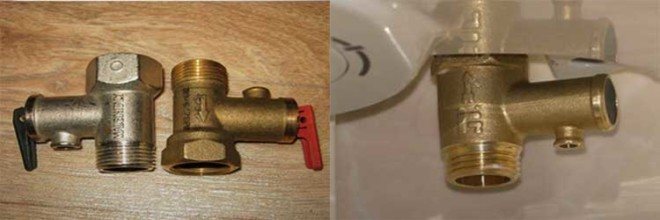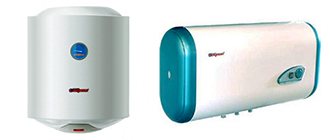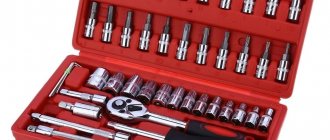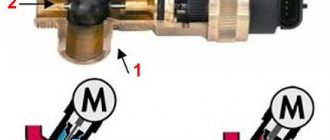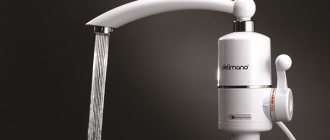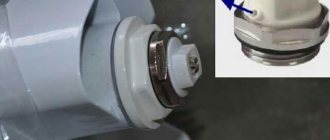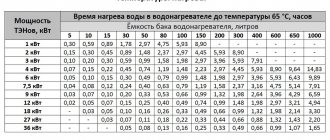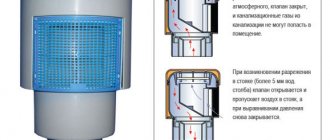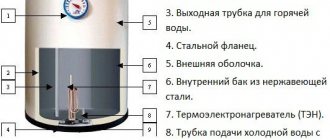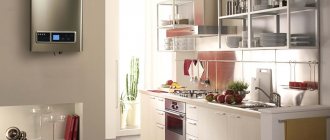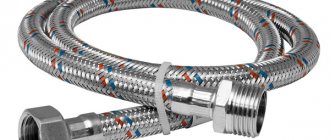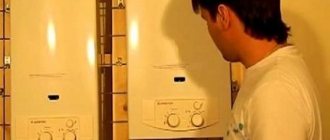The boiler operation is corrected by a safety valve. It is very important to monitor its serviceability. When it starts to drip, many questions arise: why is water dripping from the safety valve of the water heater, how much water is acceptable, how to determine its malfunction.
The main function of the device is to discharge excess water that appears when the instantaneous water heater is heated. The safety valve flows to reduce the internal pressure of the boiler. Water droplets appear from the valve. There are several reasons for this, it is necessary to understand them.
The valve is dripping when the boiler is off
The situation is considered when the water heating device is not included in the network, water is supplied from the water supply system. At this time, a fluid leak is observed from the drain hole of the water heater. Two reasons can lead to this process:
- the safety valve for the water heater is out of order;
- excessive pressure in the pipeline.
To determine the cause, the cold water supply pressure in the system is measured. It is the excess of the pressure indicator, which is established by SNiP, that leads to the discharge of excess water.
The device opens and performs its main function - it reduces the pressure in the tank. The standard pressure, which allows the product to operate without failure, is set by the manufacturers in the range of 6-8 atmospheres. SNiP set the maximum pressure at 6 atmospheres. In the pipeline, it often exceeds the norm by 2 units.
The valve is triggered and discharges excess water into the sewer.
The device has broken: the plate is worn out, the spring has weakened - these are the reasons that lead to the discharge of water. The situation may develop according to another scenario: particles of debris got under the plate.
A broken product cannot simply be thrown away. It is necessary to replace with a new valve, which will help to avoid dangerous accidents. A boiler operating without a safety device can cause an explosion.
Design and function of the safety valve
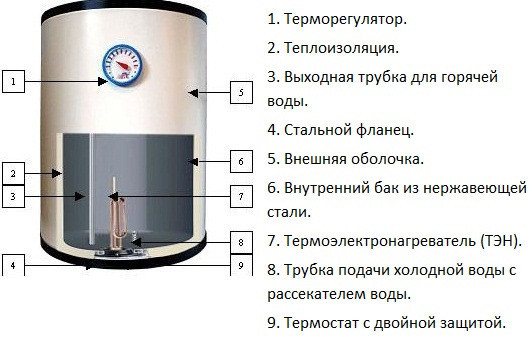
Water heater device diagram.
As a rule, each storage boiler has a check valve, which is located at the bottom of the tank. It has two main functions: protection against the flow of temporarily unused cold water from the tank and equalizing the water pressure, which is inside the heating tank.
Water drips from the boiler valve for two reasons: when the valve is malfunctioning and when the pressure rises. In the event of a malfunction, everything will be clear at once, since the water will flow constantly, and its amount will increase each time. But more often than not, it happens that water leaks from the safety valve are quite normal.
This is due to the fact that when the water pressure rises, its volume expands, as a result of which it drips from the valve. If this does not happen, then the tank may simply burst from a strong overvoltage. Experienced specialists are obliged to warn you about this when installing a boiler, and also advise you to hang a small water collector under the water heater valve in case condensation forms there.
Usually, water leakage from the valve, which is normal, appears in two cases: when the water is heated to a high temperature, or when the water pressure increases throughout the entire system in the house. This is especially true for those premises that are located on high floors.
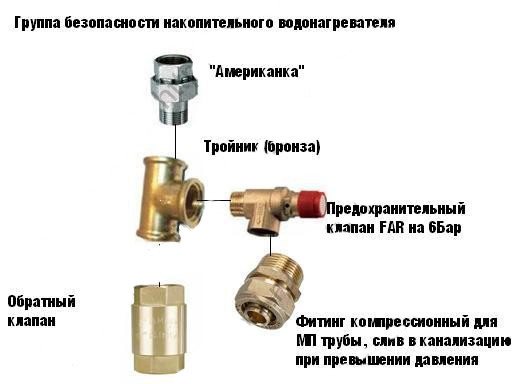

Water heater safety group.
Due to the fact that water is not always in the right amount easily enters the system of this riser, the pressure can increase several times, thereby provoking an increase in pressure in the tank itself when it is filled with water.
Often you can even predict when the strong pressure will start dripping from the valve. Most storage type boilers have a special screen with an arrow. Around the arrow there are divisions, half of which are red and half are blue. When the arrow moves to the red zone, it will indicate that the pressure in the heater is becoming critical.
The valve is dripping when the boiler is on
The situation is simulated when the water heater is on without draw-off.
- The cause of the water discharge will be valve breakage.
The explanation is simple: with the initial heating of the liquid, its volume increases by 3%. This surplus is discharged into the sewer. But after that, the heating device simply keeps the water in a constant temperature regime. There should be no dripping from the valve.
Droplets indicate that the device is malfunctioning or clogged with debris.
- The second, considered situation, paints a picture of the correct operation of the mechanism.
The water heater works with increased water intake (take a shower). The volume of hot water goes away, cold liquid enters its place. The new flow begins to heat up - “new” surplus water appears, which is continuously discharged into the sewer system.
- The third situation arises when the water intake is extended over time. The discharge of water does not have to be permanent. It drips from the safety valve periodically. This indicates the correct operation of the device.
For example, dishes are washed. The drawdown process is extended. Also, water should not drip constantly.
Why is the water heater safety valve leaking?
First of all, you should check the serviceability of the valve itself. This happens very rarely, but it is impossible to completely exclude the possibility of such a situation. The verification method is simple, but you will have to seek help from a professional - only he has a proven valve.
If the check showed that the installed valve is in good order, that is, water also drips through it, and the pressure gauge supplied at the boiler inlet shows a pressure higher than 3 atmospheres, then a reducer will need to be installed that reduces the pressure in the water supply. Since there are many types of gearboxes: they are divided both by the type of installation and by characteristics, then professional advice is also needed.
Sometimes they resort to another method by which you can get rid of valve leakage - installing an expansion tank. There are times when this is the only way to solve this problem. Can the water heater be repaired if the tank is leaking?
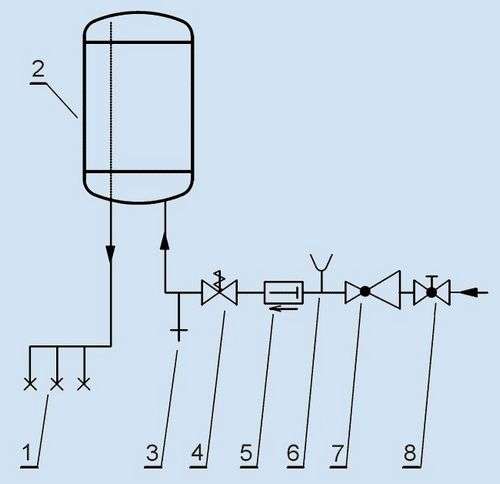

Diagram of connecting the boiler to the water supply: 1. Mixer taps; 2. Boiler; 3. Water drain pipe; 4. Safety valve; 5. Check valve; 6. Manometer; 7. Stabilizer of inlet pressure (reducer); 8. Crane.
If the owner of the water heater noticed that water is dripping from the body of the unit, first of all it is necessary to disconnect it from the power supply, otherwise the consequences can be dire. It is common for a small leak to turn into a stream of water that can spoil relations with neighbors living on the floor below for a long time. Payment for repairs may be required, significantly reducing the contents of the wallet.
In most cases, such a leak indicates the end of the water heater's service life, especially if it has been operating for at least 5 years. It is about this period that the statistics of the use of boilers (storage water heaters) speaks. At the same time, when it comes to flat-shaped boilers, an even smaller figure is called.
The first step is to determine the exact location of the leak.If water leakage occurs anywhere in the case or in the area of its upper part, then you should not waste time trying to repair: the tank has become unusable, which cannot be repaired. It is almost impossible to replace it; you will have to get ready to buy a new water heater.
Another option is when water drips from under the bottom cover of the appliance. In this case, it is necessary to remove the cover and determine the location of the leak. A hatch leading to the inside of the water heater is visible under the cover.
A rubber gasket is installed to seal it. If water drips from under the hatch, then its depressurization has occurred. Most often, it is the rubber gasket that has failed, but there is also an incorrect alignment of the flange (hatch) at the factory or during cleaning of the water heater. Usually this problem can be repaired. If it can be seen that water is flowing in other areas of the tank, then the life of the unit is over. Tools required for repair and maintenance work
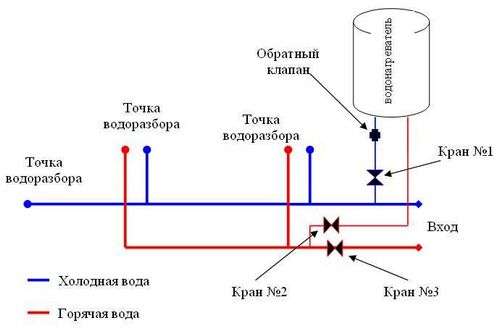

Storage water heater design.
If there is a water heater in the house, there may be a need for its prevention and minor repairs. You cannot do without tools for these important works, especially since they may be needed in other situations.
The following tools must be available:
- an adjustable wrench, the size of which must be larger than the largest nuts on the water supply system;
- a set of pipe wrenches of different sizes;
- socket wrenches;
- a set of Phillips and slotted screwdrivers;
- knife;
- a piece of rubber hose, the length of which will allow you to drain the water from the boiler into the sink or toilet;
- a digital tester will help when connecting the water heater to the mains.
Some home craftsmen believe that with minimal plumbing skills, they will be able to cope with the installation, and, if necessary, with the repair of the water heater on their own. It must be borne in mind that for the repair of such a complex household unit as a water heater, it is usually not possible to do with minimal skills. It is better if this work is entrusted to professionals.
And when water drips from under the boiler, there is no rain (snow) on the street? I had just that. I unrolled the pipes and adjusted their slope so that the water would not flow. Our houses are serviced by "Inzhservice" tel.60-40-08.A in general, our homeowners' association concludes an agreement for servicing boilers.
DMITRY8
, it does not seem to drip, but just starts pouring, as if from the tap, not much, 10-20 seconds and it will stop, while it seems like the pressure in the boiler is less, but I still did not understand - was it less until the moment leaks or less becomes after. It feels like there is some kind of valve and why does it then open the water?
can relieve pressure
there in the instructions it should be written where which valve is
close the make-up
filters do not affect the pressure in the system, if the make-up is open, it must be closed
I had exactly the same problem. It was solved by replacing the pump that drives water through the batteries when it completely dripped and stood up completely. The price of the issue is approximately 5000.
this is where the heating system connects to the water through a valve
anyway it relieves pressure through the safety valve at the top, and because of what it rises it is necessary to look for it, call the gas workers to figure it out)
cdfhobr
, but in general, in heating, water should be in a vicious circle, without adding water?
Why is water dripping
The most common causes of leaks are:
- Damage to the integrity of the equipment shells.
- High pressure in the system.
- Deterioration of equipment, lack of preventive actions.
- Marriage.
- Incorrect installation.
- Safety valve breakage.
Note! The design of the water heater shut-off system includes 2 perpendicular valves: a non-return valve (on a larger tube) and a safety valve (on a smaller tube).
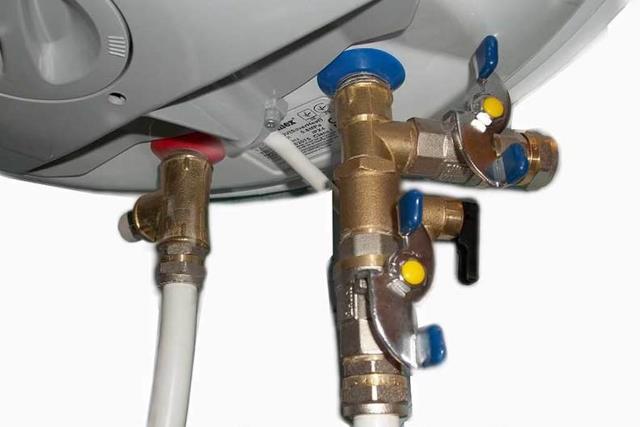

From the water heater safety valve
This valve protects the system from pressure damage by automatically releasing excess water.
Can the safety valve be replaced with a non-return valve?
Not! Absolutely not! When a check valve is installed instead of a safety one, such a situation is quite real (if the thermostat fails): the heating element has brought the water to a boil, the pressure rises. If the pressure is 10 atm. boiling point of water = 180 0С. And the higher, the more.
Suppose the boiler withstood all this. But someone will turn on the tap or the mixer hose will burst. The pressure inside will immediately drop, the boiling point will drop to 100 ° C, but after all, it is already heated much more! There will be an instant boiling up of the entire mass, the release of steam and, as a result, an explosion.
What to do?
There can be several reasons for the excessive pouring of water through the nozzle of the valve device, and the solution to the problem is very different in complexity and technology of execution:
- when the element loses its protective qualities due to wear, including the stretching of the spring and cracking of the poppet device, the reinforcement is replaced;
- in the event of a valve breakdown as a result of a water hammer with a sharp increase in the pressure in the water supply system, it is also advisable to replace the element with a new one, with similar indicators;
- if the nozzle or the inside of the system is clogged with debris and scale, it is advisable to clean, partially or completely replace;
- if the leak is caused by an initially incorrect installation of the protective assembly, then it is necessary to diagnose the safety valve, including measuring the relief pressure using a manometer, followed by replacing the valve if necessary;
- if the abundant outflow of water and the incorrect operation of the fittings of the water heating device are provoked by non-compliance with the installation requirements, then the protective assembly should be moved to the correctly selected place.
After the correct transfer of the safety fittings or the complete replacement of the safety assembly has been carried out, the excessive outflow of water should stop. The opposite effect is observed when the nominal pressure level declared by the manufacturer does not correspond to the real indicators.
Equally often, the cause of leakage is an incorrectly selected or too high temperature regime for heating water, as well as an excessive water pressure inside the system, therefore, the purchased water heating equipment must fully meet all the requirements.
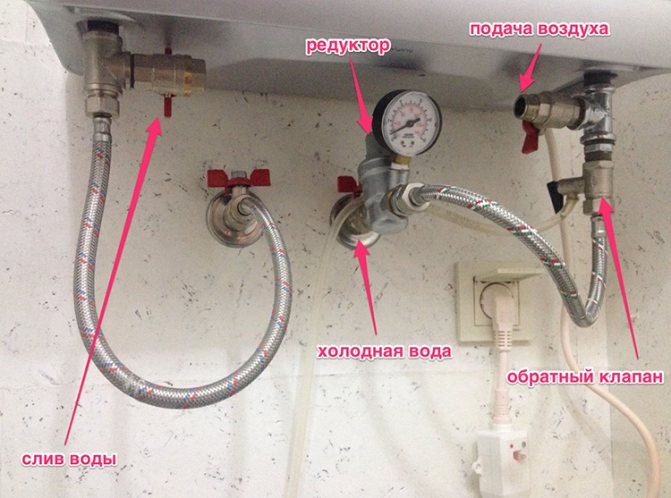

Correctly installed boiler
It is very important to remember that the operation of hot water equipment without such accessories as a safety valve device is strictly prohibited. When arranging an alternative hot water supply system in conditions of excessive pressure in the main water supply, a special reducer must be installed at the entrance, capable of regulating such parameters.
Do you want to save on boiler installation? How to connect a water heater to the water supply in an apartment - you will find a connection diagram in the article.
We will consider the types of plastic panels for the bathroom and repair options in this material.
A prerequisite for the comfortable and safe operation of hot water equipment equipped with a safety valve device is the supply of a flexible transparent hose to the drainage hole, the other end of which is led into the sewer system or a container specially installed to collect the released water.
Dripping or leaking?
If water drips from the check valve device during the heating of the boiler equipment, then this situation indicates the normal operation of the device and the operation of the protective group in normal mode.
The safety valve during the operation of the hot water device must discharge excess liquid if an increase in the water pressure on the walls of the storage tank is noted as a result of thermal expansion of the liquid. The consequence of the water discharge is a noticeable decrease in the water pressure inside the tank with heating elements.
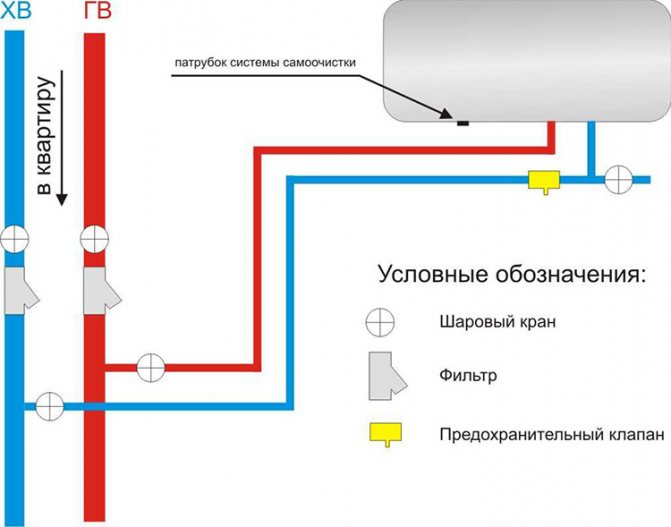

Boiler safety valve installation diagram
To monitor the process of removing excess water, it is necessary to install an ordinary transparent reinforced plastic pipe on the outlet fitting, the outlet of which is mounted on the sewer system.
Water should not flow in a stream, and the release of drops stops immediately after cooling.
If water is constantly dripping, then the problem may be a malfunction of the safety valve device or the liquid is being drained due to a worn rubber or silicone seal..
Fuse assignment
There are three main tasks that a safety valve performs:
- ensures the safe operation of the water heater;
- protects heating elements from dry heating;
- if necessary, allows you to drain the water from the water heater.
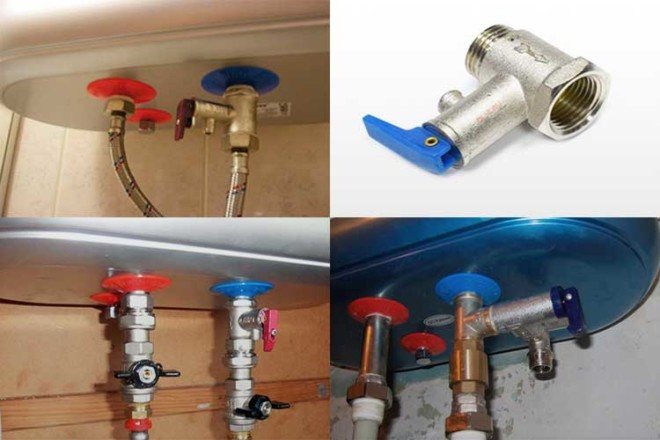

The safety valve is installed on storage water heaters (boilers). To better understand its principle of operation, you need to know how the boiler works and how it works.
The storage water heater contains water throughout the entire period of operation. The heating element turns on depending on the temperature to which the thermostat is adjusted.
Cold water enters the water heater through a branch pipe at the bottom of the tank. Hot water flows out of the tank through a pipe, which is built into the bottom and installed inside, so that its upper end almost reaches the top of the container.
This allows you to select first the upper layer, which has a higher temperature, while cold water enters from below.
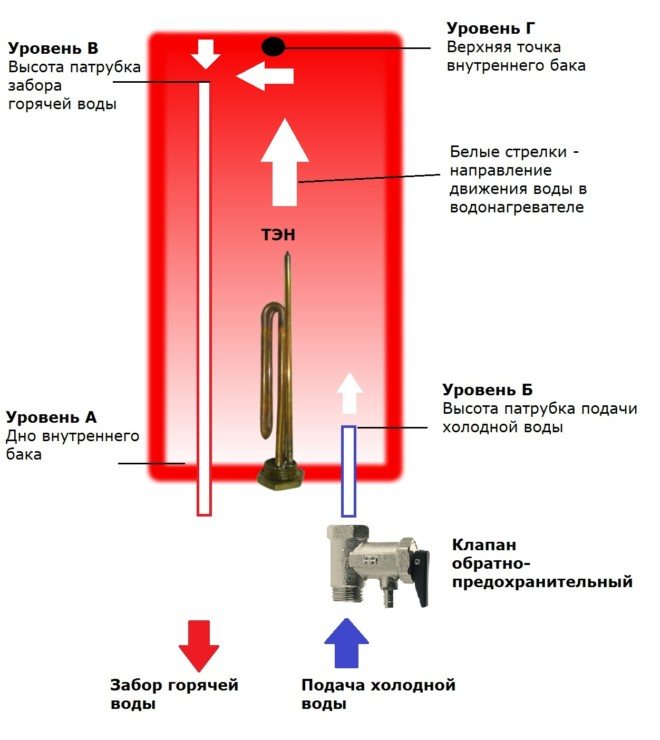

If there is not enough backwater in the line, then the water can be drained through the pipe, which is designed for filling.
If there is no water, the heating elements will simply overheat and burn out. Even if they do not have time to burn out before the start of filling, water, hitting the hot metal, quickly boils, forms a large amount of steam, which will create a very high pressure. This pressure will be enough to destroy the device.
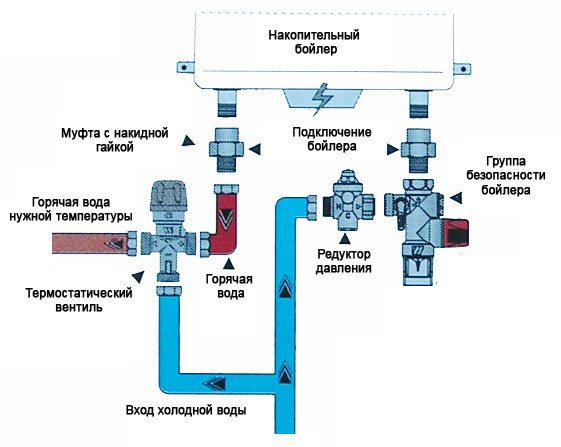

To prevent an explosion from happening, it is necessary to install a check valve for the water heater, which must be located on the inlet pipe for cold water. In this case, when the back pressure in the cold pipeline decreases, liquid will always remain in the tank, which prevents the heating elements from overheating.
But installing a check valve alone is not enough. Moreover, if you establish only it, the consequences can be even worse than in its absence.
The water entering the water heater will stop as soon as the pressure in the boiler equals the pressure in the cold pipeline. After the start of heating, the water will expand inside, and with the taps closed for parsing hot water, it simply has nowhere to go and the pressure will begin to increase. All this is fraught with an explosion, the consequences of which can be the most unpredictable and tragic.
Obviously, for normal operation, you just need to provide a drain device that will produce an emergency water discharge when the pressure reaches a certain threshold (excess value). It is realized as a safety relief valve for the boiler.
What is the safety valve on the boiler for?
The valve element releases the excess liquid in an automatic mode, and stops the removal of water in conditions of normalization of the working pressure.
Externally, the safety valve device is a brass plated body. The interior includes a pair of springs and locking elements.
The starting spring mechanism is located in the interior of the flow channel. Having the function of a non-return valve, such an element prevents backflow of water into the pipeline supply system.
With an increase in the water pressure, the spring device deviates, which ensures the unhindered flow of water into the storage tank. After filling the tank completely and with two-way equalization of the pressure indicators, the shut-off device closes the hole, which prevents the backflow of the water flow into the pipeline system.
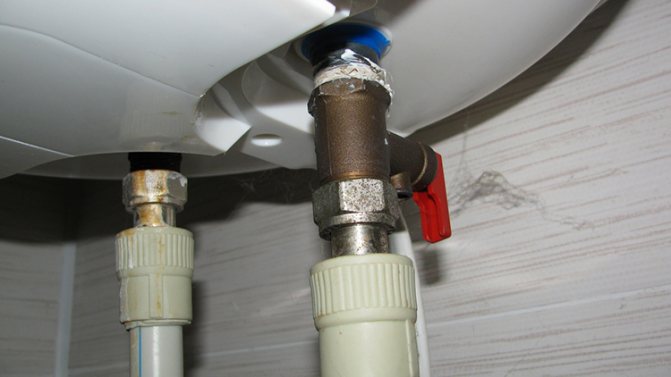

Safety valve on the supply line to the boiler
The second spring mechanism is located on the outlet part of the device, and the function of such an element is represented by water discharge under conditions of increasing pressure.
In such a situation, the pressure arising in the pipeline is able to overcome the stiffness of the spring, which causes its compression and the opening of the hole for the water flow by the shut-off element.
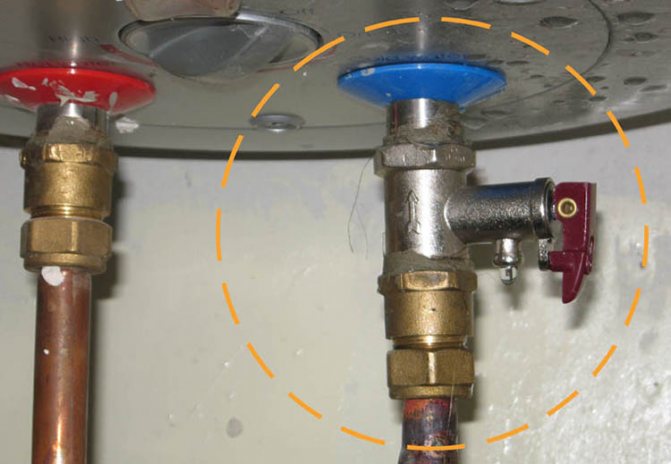

Boiler-mounted safety valve
The use of a safety valve device protects the storage tank from bursting, prevents hot water from being thrown from water heating equipment into the water supply system, smooths out pressure drops, and ensures that excess water is released at a critical level of pressure and temperature conditions. Among other things, the valve is used to drain water at the stage of boiler maintenance and repair.
Device and principle of operation
The Serious Accident Prevention Device looks surprisingly simple and is small in size - fits in the palm of your hand. It is a small mechanism consisting of two perpendicularly located spring-loaded valves, enclosed in one metal body. In fact, these are two cylinders (tubes), one of which is slightly larger than the other.
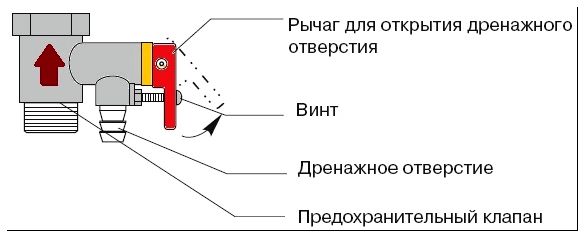

The first, larger diameter, typically 1/2 inch, double-threaded tubing has a check valve that allows fluid to pass through in one direction only. The flap in it is located across the pipe and can move along it for several millimeters, opening or closing the passage.
Under the action of pressure directed towards the water heater, the sash opens, compressing the spring. As soon as the pressure in the pipeline and behind the leaf is equalized, the valve is closed by the spring.
In a tube of smaller diameter, located perpendicular to the first, a second valve is installed, the spring of which is adjusted to open at a certain pressure exceeding the pressure for the first valve. This is the explosion protection fuse.
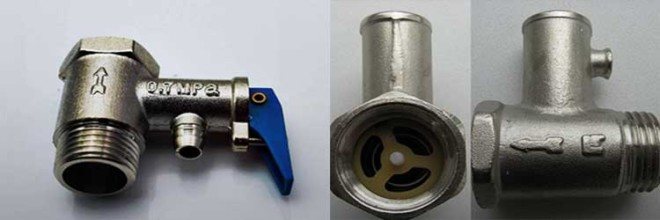

Thus, when the pressure rises and the check valve does not allow water to go into the cold supply line, the second valve opens and it is discharged through the drain pipe.
There may be special notches on the nozzle, which make it easy to put on a hose of a suitable diameter. This hose must be secured with a clamp and brought out either into the sewer or into a container, which will have to be emptied from time to time. This will have to be done infrequently, since the amount of water squeezed out during the operation of the water heater will be small.
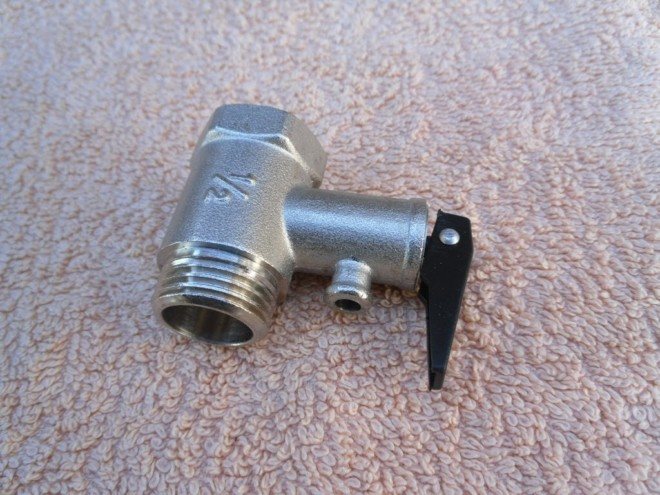

Very often, a plastic flag is provided in the design for the forced opening of the drain device. It can be used to check the functionality of the fuse. To do this, you just need to open it and make sure that the piston stroke is free, it is not clogged with rust and scale, there is enough spring force to return the valve to the closed state.
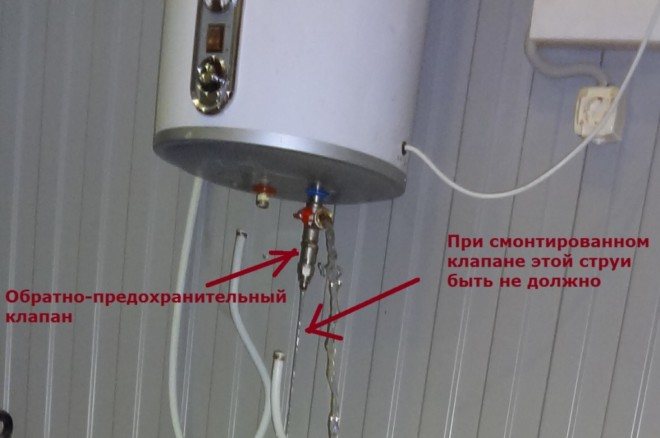

There is often an arrow on the safety valve body to show the direction of water movement to facilitate installation.The small nipple is usually marked with the pressure in pascals at which the emergency valve opens.
